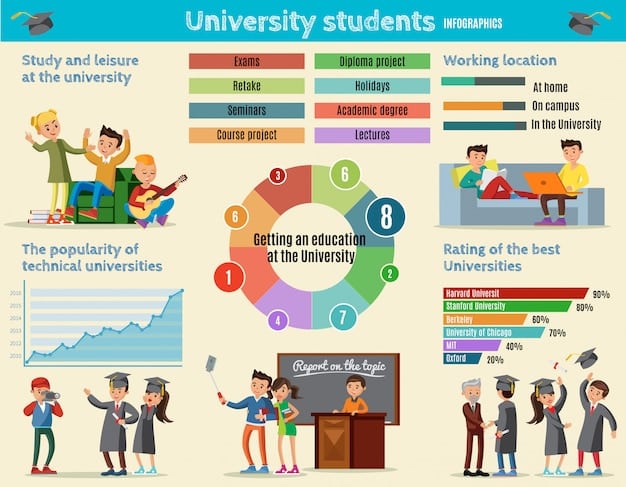Early College High Schools: Financial Boost for Students?

Early College High Schools: A Financial Head Start for Students? Data-Driven Analysis explores how these innovative models potentially reduce college costs and accelerate career readiness for diverse student populations, offering a unique blend of secondary and post-secondary education.
In an educational landscape evolving rapidly, the concept of Early College High Schools: A Financial Head Start for Students? Data-Driven Analysis stands out as a transformative model, offering a dual enrollment pathway designed to accelerate academic and career trajectories. This approach aims to reduce the financial burden of higher education while preparing students for success beyond high school.
understanding the Early College High School Model
Early College High Schools (ECHS) represent a distinct and increasingly popular educational pathway that allows students to earn both a high school diploma and a significant number of college credits, often an associate degree, simultaneously. This model is built on the premise of reducing financial and social barriers to higher education, particularly for underserved populations. Unlike traditional dual enrollment, ECHS are designed as whole-school models, meaning students are immersed in a college-going culture from day one, often on college campuses or in dedicated facilities that replicate a college environment. The curriculum is meticulously integrated, aligning high school coursework with college-level requirements, fostering a seamless transition between secondary and post-secondary education.
The philosophical underpinning of ECHS is rooted in equity and access. Many programs specifically target students who may be first-generation college-goers, from low-income backgrounds, or those historically underrepresented in higher education. By demystifying the college experience and embedding college coursework within the high school setting, ECHS aim to increase college matriculation and completion rates. This proactive approach not only prepares students academically but also mentally and emotionally for the rigors of higher education, diminishing the intimidation factor often associated with the transition from high school to college.
Core Components of ECHS
- Integrated Curriculum: High school courses are aligned with college-level expectations, often taught by college professors or high school teachers credentialed to teach college courses.
- Support Systems: Comprehensive counseling, mentoring, and academic support services are crucial to help students navigate the demands of college-level work and the transition.
- College Culture Immersion: Students often spend significant time on college campuses, utilizing college resources like libraries, labs, and student services, fostering a sense of belonging in a higher education environment.
- Cost Savings: A primary benefit, as students earn college credits tuition-free, significantly reducing the overall cost of a bachelor’s degree.
The success of the ECHS model hinges on strong partnerships between K-12 school districts and institutions of higher education. These collaborations are essential for curriculum alignment, faculty development, and ensuring that earned college credits are transferable and applicable towards future degrees. The commitment from both sides ensures that students receive a rigorous, yet supportive, educational experience that truly prepares them for post-secondary success.
In essence, ECHS are more than just a place where students take a few college classes. They are comprehensive programs designed to cultivate college readiness, reduce financial obstacles, and provide a clear pathway to higher education and beyond. This foundational understanding is critical as we delve deeper into the tangible financial benefits these schools offer.
The Financial Advantage: Reducing College Debt
One of the most compelling arguments for Early College High Schools is their potential to significantly reduce the financial burden of a college education. In an era of escalating tuition fees and mounting student loan debt, the ECHS model emerges as a powerful antidote. By allowing students to earn 30, 60, or even more college credits—often tuition-free—before graduating high school, these programs effectively shave years off a traditional four-year degree, thereby cutting down costs dramatically. The financial savings are not merely hypothetical; they translate into tangible reductions in tuition, fees, textbooks, and sometimes even room and board expenses that would otherwise accumulate during the freshman and sophomore years of college.
Consider the average cost of college. According to the College Board, the average tuition and fees for the 2023-2024 academic year ranged from approximately $11,260 for in-state public universities to $41,540 for private universities. Earning two years’ worth of credits (or an associate degree) at an ECHS could save students and their families tens of thousands of dollars. This financial head start is particularly impactful for low-income and middle-income families, who might otherwise view a four-year degree as an unattainable luxury due to its prohibitive cost. For these families, ECHS can transform higher education from a distant dream into an accessible reality.
Direct Cost Savings
- Tuition and Fees: The most significant saving, as ECHS agreements typically cover these costs.
- Textbooks and Materials: Many ECHS programs also cover the cost of college textbooks, which can be hundreds to thousands of dollars per year.
- Reduced Time in College: Graduating with an associate degree means students often enter a four-year university as juniors, reducing their overall time in a degree program and the associated living expenses.
Beyond the direct monetary savings, there’s an invaluable psychological benefit. Students who graduate from ECHS with significant college credits often report less financial stress and greater confidence in pursuing further education. This reduced financial pressure can lead to better academic performance and a more focused college experience, free from the overwhelming shadow of debt. Furthermore, by experiencing college-level coursework and earning credits early, students are less likely to incur debt for courses they might struggle with or eventually drop, a common pitfall for traditional freshmen.
The investment made by K-12 districts and state governments into ECHS programs is often recouped through future workforce development and increased tax revenues from a more educated populace. From a societal perspective, these programs are an investment in human capital, leading to a more skilled workforce and stronger economic growth. For individual students, the financial head start provided by ECHS can be the difference between crippling student loan debt and a springboard into a financially stable future, aligning academic achievement with economic upward mobility.
Beyond Tuition: Hidden Financial Benefits
While the reduction in tuition and fees is the most apparent financial advantage of Early College High Schools, a closer examination reveals a myriad of less obvious, yet equally significant, monetary benefits. These “hidden” financial advantages extend beyond the direct cost of education, impacting students’ long-term earning potential, career trajectories, and overall financial stability early in adulthood. One critical aspect is the accelerated entry into the workforce. By graduating with an associate degree or a substantial number of college credits, ECHS students can enter the job market with enhanced qualifications much sooner than their peers who follow traditional educational paths. This earlier entry into specialized fields or higher education means an earlier start to earning a professional salary, which can profoundly impact lifetime earnings.
Moreover, the academic rigor and the development of essential college-level skills, such as time management, critical thinking, and advanced research, are invaluable. These skills are highly sought after by employers, often leading to better job prospects and higher starting salaries. Students who have successfully navigated college coursework while still in high school demonstrate a unique blend of maturity, discipline, and academic prowess, making them attractive candidates in competitive job markets or for seamless transfer into top university programs. This preparedness translates into a reduced likelihood of needing remedial courses in college, which can be costly and delay degree completion for traditional students.

Long-Term Financial Implications
- Increased Earning Potential: Studies consistently show that individuals with college degrees earn significantly more over their lifetimes. ECHS graduates get a head start on this earning trajectory.
- Reduced Opportunity Cost: By accelerating college completion, students spend less time out of the workforce, accumulating valuable work experience and income sooner.
- Enhanced Scholarship Opportunities: ECHS graduates often stand out in college applications, potentially increasing their eligibility for additional scholarships and grants for their remaining bachelor’s degree studies.
- Skill Development for Future Careers: Exposure to college-level content fosters critical thinking and problem-solving skills, highly valued in today’s dynamic job market.
The early exposure to college environments also helps students make more informed decisions about their academic and career paths. This clarity can prevent costly changes in major or transfers between institutions, scenarios that often prolong time to degree and increase overall educational expenses. Students are more likely to choose a major and career path that genuinely aligns with their interests and strengths, leading to greater job satisfaction and less likelihood of career “false starts” that can be financially draining.
Furthermore, ECHS students often develop a robust professional network earlier. Interacting with college faculty and peers provides valuable connections that can lead to internships, mentorships, and future job opportunities. These networks are crucial for career advancement and can open doors that might otherwise remain closed. The sum of these hidden financial benefits—earlier career entry, higher earning potential, informed decision-making, and professional networking—paints a broader, more impactful picture of the financial advantage offered by Early College High Schools, making them an economically prudent choice for aspiring students and their families.
Data Speaks: Evidence from Success Stories
The theoretical benefits of Early College High Schools are compelling, but their true impact is best understood through the lens of empirical data and reported success stories. Research and longitudinal studies consistently highlight the effectiveness of the ECHS model in achieving its stated goals: increasing college readiness, boosting matriculation rates, and reducing educational costs. One of the most frequently cited indicators of success is the high rate of college enrollment among ECHS graduates compared to their traditional high school counterparts. For instance, data from various studies conducted by organizations like Jobs for the Future (JFF) and the American Institutes for Research (AIR) show that ECHS students enroll in two- or four-year colleges at significantly higher rates, often exceeding 90% in many programs, which is considerably above national averages.
Beyond mere enrollment, ECHS graduates also demonstrate higher rates of persistence and completion in higher education. This suggests that the early college experience not only facilitates entry into post-secondary institutions but also equips students with the academic and non-academic skills necessary to succeed once there. The associate degrees earned tuition-free translate directly into substantial financial savings. For a student graduating with an associate degree from an ECHS, this can mean entering a four-year university with two years of college already paid for, potentially saving families upward of $20,000 to $80,000 depending on the institution and state.
Case studies from various states further underscore these benefits. In North Carolina, the statewide Early College High School initiative has shown remarkable results, with students consistently outperforming their peers in college enrollment and degree attainment, particularly among minority and low-income populations. Similarly, Texas’s extensive network of ECHS programs has been lauded for transforming educational outcomes and providing pathways to economic mobility for thousands of students who might otherwise not have pursued higher education. These programs often report that their graduates are more likely to pursue STEM fields and other high-demand careers, contributing to a more skilled workforce.

Key Data Points Illuminating Success
- Higher College Enrollment: ECHS graduates consistently enroll in colleges and universities at rates far exceeding national averages.
- Increased Degree Attainment: Evidence suggests ECHS students are more likely to earn bachelor’s degrees within a shorter timeframe after high school graduation.
- Significant Financial Savings: Graduates save vast sums in tuition and related college expenses, translating into reduced student loan debt.
- Equity and Access: ECHS programs disproportionately benefit underserved student populations, narrowing achievement gaps and promoting educational equity.
Moreover, the anecdotal evidence from students and families is equally powerful. Testimonials frequently highlight increased confidence, improved study habits, and a clearer sense of purpose fostered by the ECHS environment. Parents often express immense relief at the financial burden lifted, enabling their children to pursue higher education without incurring crippling debt. The success stories from ECHS programs are not just about numbers; they are about transformed lives, expanded opportunities, and a tangible step towards a more equitable and educated society. The data, both quantitative and qualitative, emphatically supports the ECHS model as a financially savvy and academically enriching pathway for students.
Challenges and Considerations for ECHS Implementation
While the benefits of Early College High Schools are substantial and well-documented, their successful implementation is not without challenges. These hurdles often involve complex issues related to funding, partnerships, curriculum development, and student support. One primary challenge is securing and sustaining adequate funding. Although ECHS models aim to save students money, they require significant upfront investment to establish and maintain strong partnerships between K-12 districts and higher education institutions. This funding is crucial for covering tuition costs, providing necessary student support services, and ensuring faculty have the credentials to teach college-level courses. States and districts must weigh the initial investment against the long-term societal and economic benefits.
Another critical consideration lies in the quality and alignment of partnerships. A successful ECHS depends on a robust and collaborative relationship between the high school and the partner college or university. This includes seamless credit transfer agreements, consistent faculty training, and shared commitment to student success. Mismatched expectations, bureaucratic hurdles, or a lack of continuous communication can undermine the effectiveness of the program. Ensuring that college credits earned are universally accepted by other institutions is also a recurring concern for students wishing to transfer to universities beyond their ECHS partner.
Operational Hurdles for ECHS
- Funding Sustainability: Ensuring consistent financial support from state legislatures, local districts, and higher education partners.
- Partner Alignment: Maintaining strong, coordinated relationships between high schools and colleges regarding curriculum, student services, and credit transfer.
- Maintaining Academic Rigor: Balancing the need for college-level challenge with appropriate support for high school students, many of whom may be first-time college-goers.
- Student Readiness: Identifying and supporting students who can thrive in a demanding, accelerated academic environment.
Curriculum development and faculty readiness also present significant challenges. High school teachers often need additional certifications or professional development to teach college-level material, and colleges must adapt their courses to be accessible yet rigorous for high school students. Maintaining academic standards while providing adequate support for students who may not yet be socially or emotionally ready for a full college experience requires careful planning and dedicated resources. Issues such as student transportation to college campuses, access to college resources, and integration into the college social environment also need thoughtful solutions.
Finally, equitable access remains a key consideration. While ECHS aim to serve underserved populations, there’s a delicate balance to ensure that these programs don’t inadvertently create new forms of educational stratification. Recruitment efforts must be broad and inclusive, and support services must be tailored to address the unique needs of diverse student bodies. Addressing these challenges effectively requires ongoing commitment, innovative solutions, and a willingness to adapt the ECHS model to meet the specific needs of each community it serves. Only by confronting these complexities head-on can ECHS truly fulfill their potential as engines of educational equity and financial empowerment for students.
Early College & Career Pathways: The Broader Economic Impact
The influence of Early College High Schools extends significantly beyond just individual financial savings; they play a crucial role in shaping broader economic landscapes by accelerating career pathways and addressing essential workforce needs. By integrating a focus on career readiness alongside academic rigor, ECHS models align educational outcomes with industry demands, preparing students for high-skill, high-demand jobs faster than traditional educational routes. This alignment is particularly impactful in fields experiencing critical shortages, such as healthcare, advanced manufacturing, information technology, and STEM-related professions. When students graduate from ECHS with an associate degree or valuable industry certifications, they are often immediately employable or significantly advantaged in pursuing specialized higher education.
This early entry into career pathways contributes to regional economic development. A more skilled local workforce attracts new businesses, fosters innovation, and strengthens existing industries. ECHS programs, especially those designed with specific workforce needs in mind, become pipelines for talent, reducing the time and cost associated with training new employees from scratch. This symbiotic relationship between education and industry creates a virtuous cycle: businesses benefit from a readily available pool of qualified candidates, and students gain access to meaningful employment opportunities, often with higher earning potential and clearer paths for advancement.
Economic Ripple Effects of ECHS
- Skilled Workforce Development: ECHS produce graduates ready for immediate employment in critical sectors, filling labor gaps.
- Economic Competitiveness: Regions with strong ECHS programs become more attractive to businesses seeking skilled workers.
- Reduced Unemployment: Graduates are better equipped for stable, high-paying jobs, lowering regional unemployment rates.
- Increased Tax Revenue: Higher earning potential for graduates leads to increased tax contributions, benefiting local and state economies.
Furthermore, ECHS contribute to social mobility and poverty reduction on a systemic level. By providing a clear, affordable pathway to higher education and skilled employment for students from low-income backgrounds, these schools break cycles of intergenerational poverty. Graduates who might otherwise be burdened by student loan debt can achieve financial independence sooner, purchase homes, start businesses, and contribute more robustly to their communities. This creates a more equitable distribution of economic opportunity and wealth, fostering stronger, more resilient communities.
The strategic development of ECHS in specific geographic areas can also target local economic development goals. For example, an ECHS in a rural area might focus on agricultural sciences or renewable energy, aligning directly with the region’s economic base. In urban centers, programs might emphasize tech or healthcare. This localized approach maximizes the broader economic impact, ensuring that educational investments yield tangible benefits for both individuals and the collective economy. Ultimately, Early College High Schools are not just educational programs; they are economic engines, driving human potential and contributing significantly to the prosperity of communities and nations.
Future Outlook: Scaling and Sustaining ECHS Impact
The proven success and growing recognition of Early College High Schools suggest a promising future, but scaling their impact and ensuring their long-term sustainability require strategic foresight and continued innovation. As the model gains traction, a critical focus must be placed on replication without dilution of quality. Expanding ECHS programs means not just opening more schools, but ensuring that each new institution adheres to the core principles that have made existing models successful, including rigorous academics, comprehensive student support, and strong college partnerships. This often necessitates robust professional development for educators and administrators, and careful planning to address local context and needs.
One key aspect of future sustainability involves diversifying funding streams. While state and federal grants have been instrumental in launching many ECHS programs, long-term viability often depends on securing stable, ongoing funding from a mix of public, private, and philanthropic sources. Advocating for sustained state legislative support and establishing local endowments or business partnerships can help buffer programs from economic fluctuations. Moreover, demonstrating clear return on investment to taxpayers—through higher college completion rates and a more skilled workforce—is essential for garnering continued public support.
Future Growth and Sustainability Pillars
- Quality Replication: Expanding the ECHS model while maintaining high standards and fidelity to core principles.
- Diversified Funding: Shifting towards sustainable financial models that combine state, local, private, and philanthropic support.
- Policy Advocacy: Championing state and federal policies that support the growth and effective operation of ECHS.
- Innovation and Adaptation: Evolving curricula and support services to meet changing workforce needs and student demographics.
Policy advocacy also plays a pivotal role in the future of ECHS. Crafting and supporting legislation that streamlines credit transfer, provides clear guidelines for dual enrollment, and incentivizes K-12 and higher education collaboration can significantly ease the path for new ECHS programs. Eliminating administrative barriers and creating clear pathways for students to transition seamlessly from high school to college and into careers will be paramount. Additionally, integrating ECHS into broader state education strategies, rather than viewing them as isolated initiatives, can ensure their long-term relevance and impact.
Finally, continuous innovation and adaptation are crucial. The world of work and higher education is constantly evolving, and ECHS must evolve with it. This means regularly reviewing and updating curricula to align with emerging industries, incorporating new technologies, and providing flexible learning modalities. It also involves expanding the types of early college programs available, perhaps including more career-technical education pathways or specialized programs that cater to unique student interests and talents. By embracing these challenges and opportunities, Early College High Schools can continue to be powerful forces for educational equity and economic empowerment, securing a brighter financial future for countless students for generations to come.
| Key Point | Brief Description |
|---|---|
| 💸 Cost Savings | Students earn significant college credits tuition-free, reducing overall higher education expenses. |
| 🎓 Accelerated Path | Faster entry into workforce or continuation to a bachelor’s degree, saving time and money. |
| 📈 Higher Success Rates | ECHS graduates show higher college enrollment and completion rates compared to peers. |
| 🌎 Economic Impact | Contributes to a skilled workforce and economic development, benefiting communities. |
Frequently Asked Questions about Early College High Schools
▼
An Early College High School (ECHS) is an innovative high school program that allows students to earn both a high school diploma and an associate degree or up to two years of transferable college credit simultaneously. These programs often target students who would be the first in their families to attend college or who are traditionally underrepresented in higher education. The curriculum is integrated, fostering a smooth transition to collegiate studies.
▼
ECHS save money by providing college courses tuition-free. Students can complete a significant portion of their bachelor’s degree requirements while still in high school, reducing the number of semesters they need to pay for at a four-year institution. This eliminates or significantly reduces the cost of tuition, fees, and sometimes textbooks for up to two years of college education, leading to substantial savings and less student loan debt.
▼
Generally, the college credits earned at an ECHS are designed to be transferable, especially within the state’s public university system. However, transferability can vary depending on the receiving institution and the specific courses. It’s crucial for students and families to confirm credit transfer policies with their intended four-year universities to ensure the seamless application of earned credits. Most ECHS programs work closely with university partners to guarantee broad transferability.
▼
ECHS typically provide extensive support services to help students navigate the academic and social demands of college-level work. This includes dedicated academic counseling, tutoring, mentoring programs, and college readiness workshops. Many ECHS foster a strong peer support network and ensure students have access to both high school and college resources, creating an environment where students feel supported and confident in their academic journey.
▼
While ECHS can benefit any motivated student, they are often designed to particularly empower students who are first-generation college-goers, from low-income backgrounds, or those historically underrepresented in higher education. These programs provide a clear, supported, and affordable pathway to college, leveling the playing field and increasing equitable access to higher education and future career opportunities. Ambitious students seeking an academic challenge also thrive in this environment.
Conclusion
Early College High Schools stand as a beacon of innovation in education, offering a tangible solution to the escalating costs of higher education and widening access to post-secondary success. Through their integrated curriculum, supportive environments, and tuition-free college credits, ECHS not only provide a significant financial head start for students but also foster a robust academic foundation and accelerated career pathways. The data unequivocally supports their efficacy in boosting college readiness, enrollment, and completion rates, particularly for underserved populations. While challenges in funding and implementation persist, the profound individual and societal benefits—from reduced student debt to enhanced workforce development—underscore the critical value of sustaining and scaling these transformative educational models. As we look to the future, ECHS remain a powerful testament to how strategic educational design can democratize opportunity and build a more educated, equitable, and economically resilient society.





